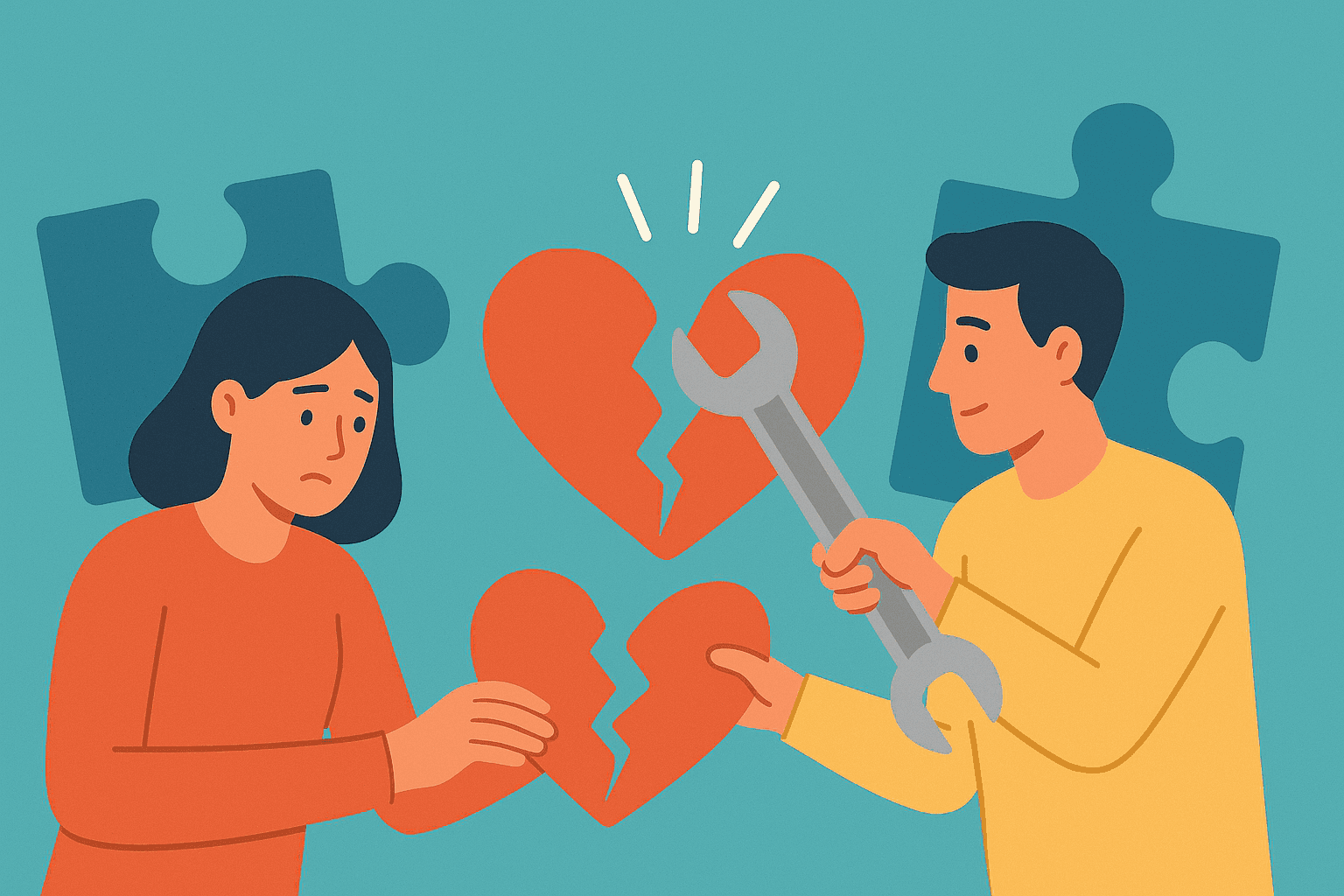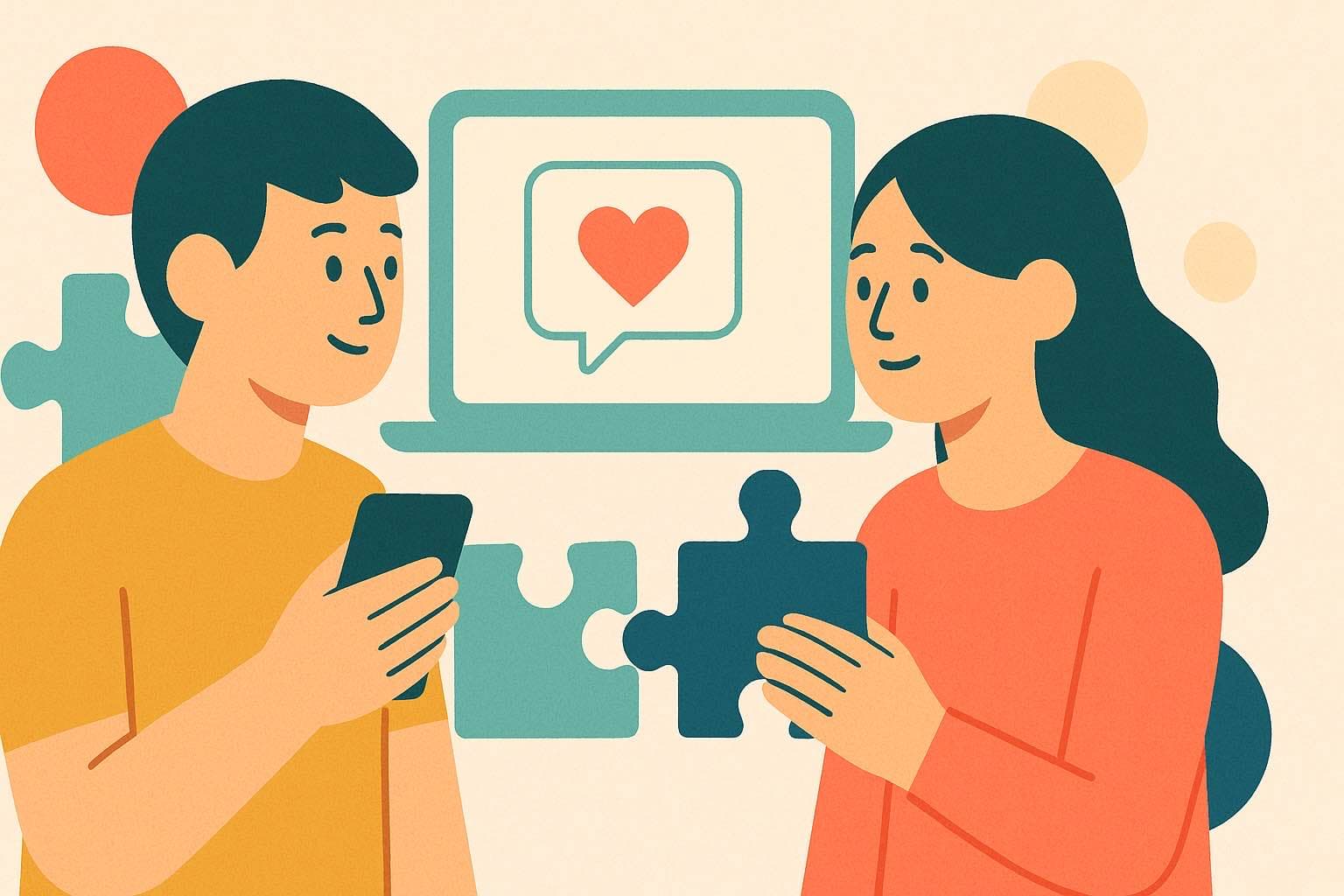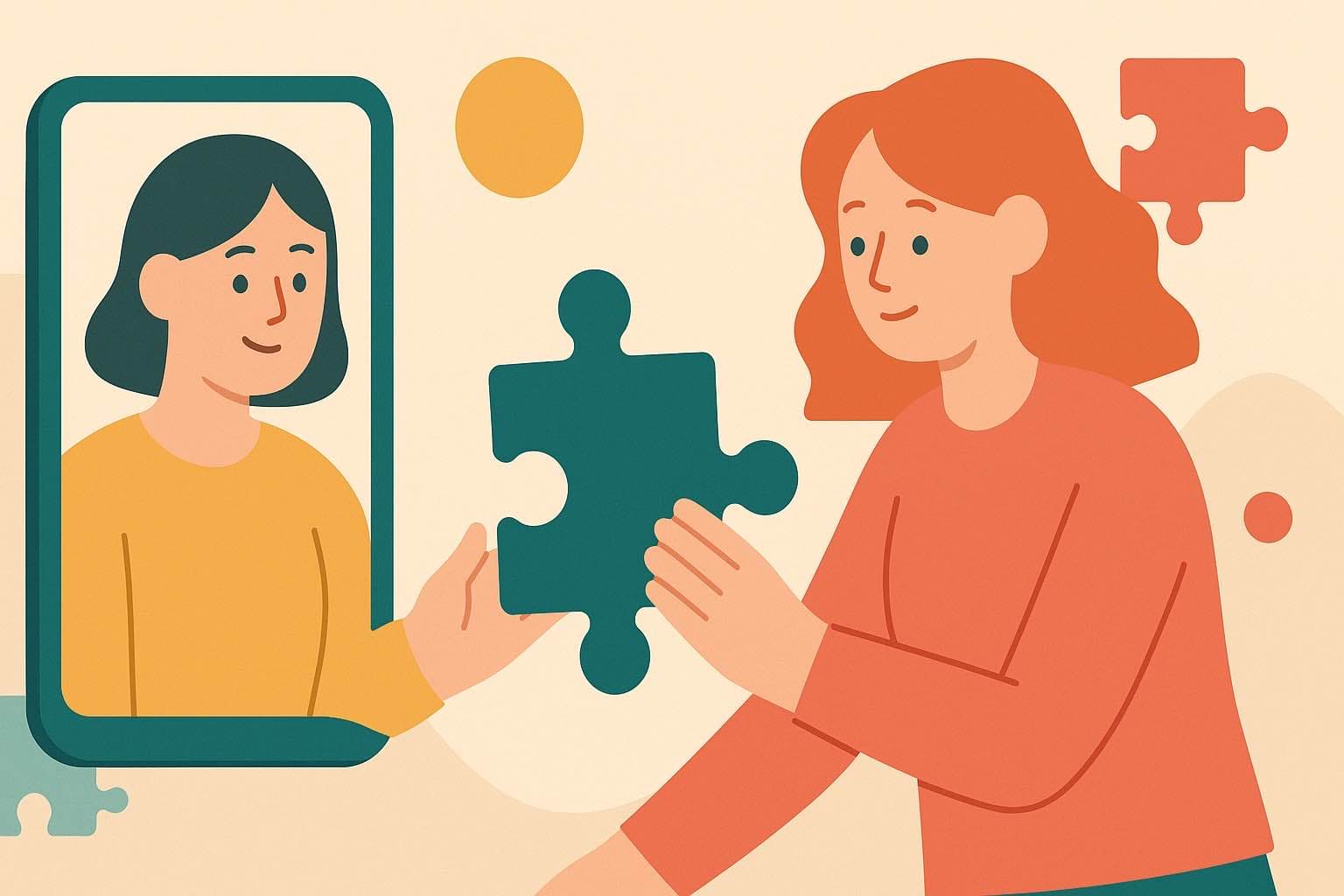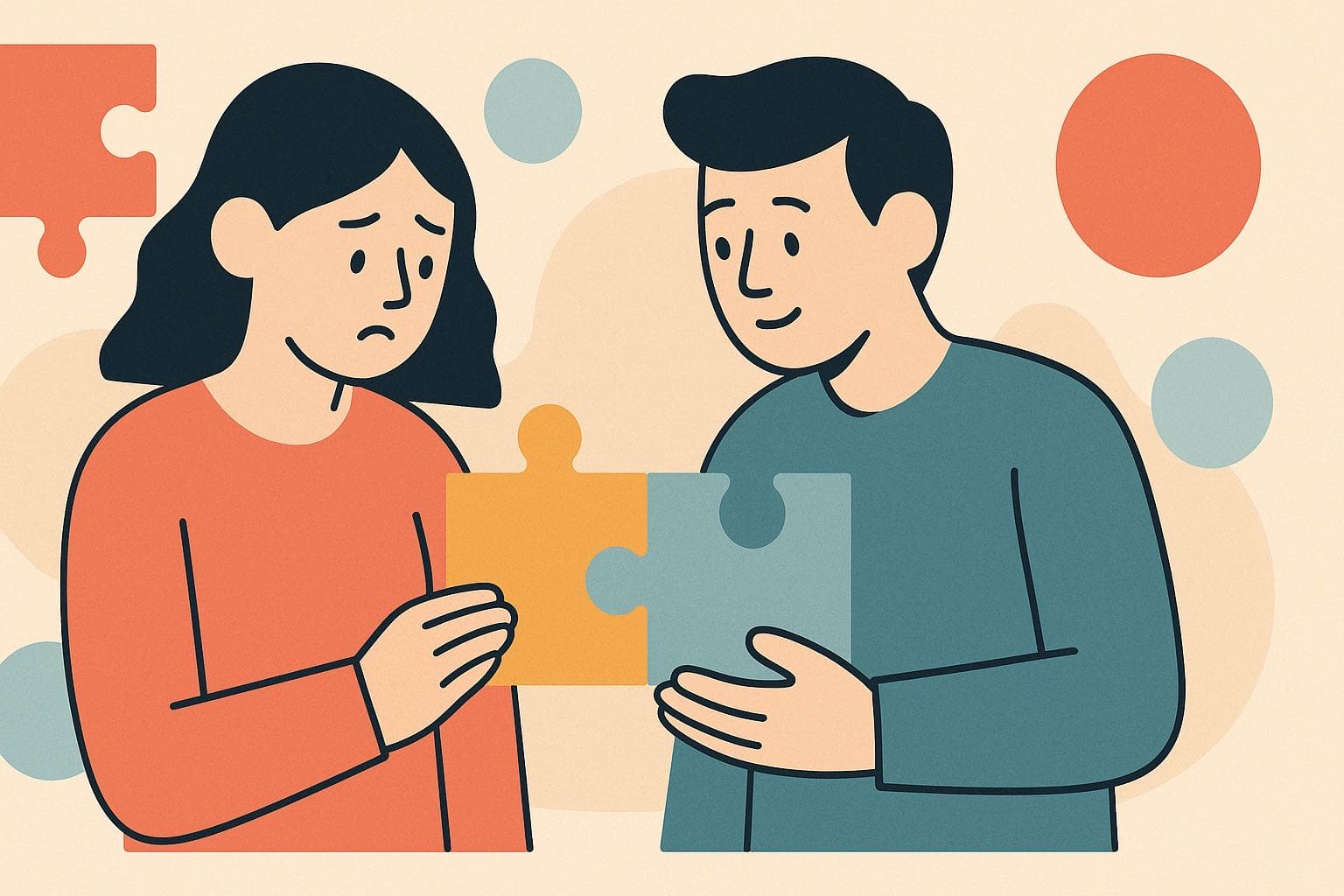How to Fix a Friendship: 7 Proven Steps to Repair Damaged Relationships in 2025
Learn how to fix a friendship with expert-backed strategies. Discover communication techniques, apology methods, and trust-building steps to repair damaged relationships effectively.

Friendships are among life's most precious gifts. Yet when these bonds fracture, the pain cuts deeper than almost any other relationship conflict. How to fix a friendship becomes a burning question when you're facing the silence of someone who once shared your secrets, laughs, and dreams.
Key Takeaways
- Friendship conflicts are normal and often strengthen bonds when handled constructively
- Self-reflection comes first - examine your role before approaching your friend
- Effective communication requires active listening, empathy, and vulnerability
- Sincere apologies must be specific, timely, and followed by consistent behavioral change
- Trust rebuilding takes patience, consistency, and mutual effort over time
- Professional help may be needed for complex relationship dynamics
- Some friendships should end if they become consistently toxic or harmful
Research shows that friendship conflicts can have profound impacts on our emotional well-being, manifesting as anxiety, depression, isolation, and lowered self-esteem. But here's the encouraging truth: most friendship rifts can be repaired with the right approach, patience, and genuine commitment to healing.
The journey to fix a friendship isn't always easy. However, with the strategies outlined in this comprehensive guide, you'll discover how to bridge the gap between hurt and healing. Whether you're dealing with a misunderstanding, betrayal, or gradual drift, these evidence-based techniques will help you restore and even strengthen your friendship.
Understanding Why Friendships Break Down
Before learning how to fix a friendship, it's crucial to understand what causes these relationships to fracture in the first place. Conflicts arise from various sources including misunderstandings, differing opinions, unmet expectations, balancing friendships with other commitments, and feelings of inadequacy that lead to jealousy.
Common Causes of Friendship Conflicts
Miscommunication stands as the leading culprit. A misunderstood text, an unintended slight, or assumptions about intentions can quickly spiral into major conflicts. Additionally, life transitions often strain friendships as people's priorities, availability, and circumstances change.
Boundary violations represent another significant factor. When friends overstep unspoken limits or fail to respect each other's needs, resentment builds. Meanwhile, jealousy and competition can poison even the strongest bonds when success disparities emerge.
Neglect plays a subtler but equally damaging role. According to relationship experts, many people reacted to recent challenges by drawing their closest friends closer while allowing more distant relationships to atrophy. When friendships aren't nurtured, they naturally begin to wither.
Self-Reflection: The Foundation of Friendship Repair
The first step in learning how to fix a friendship involves looking inward. Before facing a difficult conversation, experts recommend taking time to reflect on your friendship by asking crucial questions about what fostered your bond, what has changed, and how you contributed to the change.
Essential Reflection Questions
Start by examining these key areas:
Your contribution: What actions or words might have hurt your friend? Even if you didn't intend harm, acknowledging your role shows maturity and opens the door to healing.
Your motivations: Are you seeking to fix this friendship because you genuinely miss your friend, or do you feel guilty, lonely, or want to win an argument? Honest motivations lead to authentic repair efforts.
Your expectations: What do you realistically hope to achieve? Some friendships return stronger than before, while others may settle into a different but still meaningful dynamic.
Your boundaries: What behaviors will you accept going forward? Healthy relationships require mutual respect and clear limits.
This self-examination isn't about blame or shame. Instead, it's about gaining clarity and approaching your friend with genuine understanding rather than defensiveness.
The Psychology Behind Friendship Repair
Understanding the psychological principles underlying how to fix a friendship provides a roadmap for successful reconciliation. Research from the University of Missouri demonstrates that friendships provide a critical context for developing important relationship skills and social competencies.
The Science of Forgiveness
Forgiveness research reveals that decision-based forgiveness involves cognitive letting go of resentment and bitterness, while emotional forgiveness signals the ability to overcome physical and emotional reactions to past hurts. Both types play crucial roles in friendship repair.
Neuroplasticity offers hope for damaged relationships. Our brains can form new neural pathways around old hurts, allowing us to create fresh narratives about our friendships. This scientific understanding supports the possibility of genuine relationship transformation.
Attachment theory also influences friendship repair success. People with secure attachment styles tend to navigate conflicts more effectively, while those with anxious or avoidant patterns may need additional support to rebuild trust.
Step-by-Step Guide: How to Fix a Friendship
Now let's dive into the practical steps for repairing your friendship. This comprehensive approach addresses the emotional, communication, and behavioral aspects of reconciliation.
Step 1: Make the First Move
Research consistently shows that people underestimate how much others appreciate outreach, and typically respond well to hearing from an old friend. Don't wait for your friend to reach out first.
Start with a simple message that acknowledges the situation without overwhelming them. Consider something like: "I've been thinking about our friendship and would love to talk when you're ready." This approach shows initiative while respecting their autonomy.
Choose your medium carefully. Experts recommend starting with a baby step like a text or social media message to feel out the vibe, but emphasize the importance of eventually progressing to in-person meetings for serious reconnection efforts.
Step 2: Create a Safe Space for Dialogue
When your friend agrees to talk, suggest meeting in a neutral, comfortable environment. Avoid places with negative associations or too many distractions. A quiet coffee shop, park, or even a phone call can work well.
Timing matters significantly. Choose a moment when both of you have adequate time and emotional energy. Rushing through such an important conversation often backfires.
Set the tone by expressing appreciation and vulnerability. You might say: "I value our friendship and have missed having you in my life. I'd like to understand what happened and see if we can work through this together."
Step 3: Listen with Your Whole Heart
Active listening is fundamental but challenging because we're programmed to react. The key is giving your friend the floor completely while trying to understand why they think the friendship ended.
Resist the urge to defend yourself immediately. Instead, ask clarifying questions like "Help me understand how that felt for you" or "What would you have preferred I do differently?"
Validate their emotions even if you disagree with their interpretation. Saying "I can see why that hurt you" doesn't mean you accept blame, but it shows empathy and respect for their experience.
Step 4: Take Responsibility and Apologize
If you've identified ways you contributed to the conflict, offer a sincere, specific apology. Effective apologies include expressing regret using 'I' language, making restitution where possible, genuinely repenting, and requesting forgiveness.
Avoid non-apologies like "I'm sorry you felt that way" which shift blame rather than accepting responsibility. Instead, try: "I'm sorry I dismissed your concerns. That was disrespectful and not the kind of friend I want to be."
Don't over-explain your intentions. While context can be helpful, focusing too much on why you acted a certain way can minimize your friend's pain. The impact matters more than the intent.
Step 5: Express Your Perspective
After listening to your friend's concerns, you need to express yourself honestly without diminishing your own feelings. This step allows both parties to share their perspectives and experiences.
Use "I" statements to describe your experience without attacking your friend. For example: "I felt confused when you stopped responding to my messages" rather than "You ghosted me."
Share your emotions honestly while taking responsibility for your reactions. This vulnerability often helps friends reconnect on a deeper level.
Step 6: Collaborate on Solutions
Together, identify specific changes both of you can make to prevent similar conflicts. This might involve improved communication patterns, clearer boundaries, or different approaches to handling disagreements.
Create actionable agreements. Instead of vague promises to "communicate better," establish concrete practices like "We'll talk directly about issues within 24 hours" or "We'll ask for clarification before making assumptions."
Consider whether your friendship might work better with modified expectations or boundaries. Sometimes relationships can exist in a specific context even if they're not as close as they once were.
Step 7: Rebuild Trust Through Consistent Actions
Actions speak louder than words in rebuilding damaged friendships. The behavior after an apology is probably more important than the apology itself, as only consistent behavior modification is likely to rebuild broken trust.
Start small with reliable follow-through on minor commitments. If you say you'll text by Friday, do it. These small acts of reliability rebuild confidence in your trustworthiness.
Be patient with the process. Trust rebuilding takes time, and your friend may need space to observe your changed behavior before fully reopening their heart.
Effective Communication Strategies
Mastering how to fix a friendship requires developing strong communication skills that serve you well beyond this single repair effort.
The Art of Active Listening
Put away distractions and give your full attention. This means phones down, eye contact maintained, and mental focus on understanding rather than formulating your response.
Reflect back what you hear to ensure understanding. Try phrases like "It sounds like you felt excluded when..." or "I'm hearing that you needed more support during..."
Ask open-ended questions that encourage deeper sharing. "How did that affect you?" or "What would have felt more supportive?" invite your friend to expand on their experience.
Expressing Yourself Clearly
Use specific examples rather than generalizations. Instead of "You never listen," try "Last Tuesday when I was telling you about my job interview, I felt like you were distracted by your phone."
Focus on behaviors rather than character. Address what someone did rather than who they are. This reduces defensiveness and keeps conversations productive.
Balance honesty with kindness. You can be truthful about your hurt without being cruel or vindictive. The goal is understanding, not punishment.
Managing Emotional Intensity
Take breaks when needed. If emotions escalate beyond productive levels, suggest pausing the conversation to cool down before continuing.
Acknowledge emotions without letting them drive decisions. Saying "I'm feeling really hurt right now, and I want to make sure I'm hearing you clearly" validates your experience while maintaining focus on resolution.
Practice emotional regulation techniques like deep breathing or grounding exercises to stay present during difficult conversations.
The Power of Apology and Forgiveness
Understanding how to fix a friendship involves mastering both giving and receiving apologies effectively.
Elements of a Meaningful Apology
A complete apology includes several key components:
Acknowledgment: Clearly state what you did wrong without minimizing or making excuses.
Responsibility: Own your actions and their impact without deflecting blame.
Empathy: Show you understand how your actions affected your friend.
Commitment: Promise specific changes to prevent similar issues in the future.
Amends: When appropriate, offer to make things right through actions, not just words.
The Forgiveness Process
Research suggests that forgiveness isn't always essential for moving forward, but when achieved, it can significantly improve relationships and personal wellbeing.
Forgiveness is a choice, not a feeling. You can decide to forgive even while still processing hurt emotions. This decision-based forgiveness often precedes emotional healing.
Forgiveness doesn't mean forgetting or pretending the hurt never happened. Instead, it involves releasing the desire for revenge and choosing to move forward constructively.
Set realistic expectations about forgiveness timelines. Deep hurts may require extended time to heal fully, and that's perfectly normal.
Rebuilding Trust After Conflict
Trust forms the foundation of meaningful friendships, making its repair crucial for learning how to fix a friendship effectively.
The Trust-Building Process
Start with small commitments and follow through consistently. Reliability in minor matters demonstrates your commitment to change.
Be transparent about your growth process. Share insights you've gained from reflection and specific steps you're taking to improve.
Respect your friend's pace in reopening their trust. Pushing for immediate forgiveness or complete restoration often backfires.
Demonstrate changed behavior consistently over time. One-off gestures don't rebuild trust; patterns of positive behavior do.
When Trust Feels Impossible to Rebuild
Sometimes trust damage runs too deep for full restoration. In these cases, consider whether a modified friendship might work. Perhaps you can't be confidants again, but you could enjoy shared activities or group settings.
Accept if your friend isn't ready to rebuild trust. Respect their decision while leaving the door open for future possibilities if they change their mind.
Focus on your own growth regardless of the friendship outcome. The skills you develop in attempting repair will benefit all your relationships.
Setting Healthy Boundaries
Learning how to fix a friendship includes establishing clear boundaries that protect both parties' wellbeing going forward.
Identifying Necessary Boundaries
Consider which behaviors or topics might need limits:
Communication boundaries: How often and through which methods will you communicate?
Emotional boundaries: What level of support can you realistically provide to each other?
Time boundaries: How much time can you commit to this friendship given other obligations?
Topic boundaries: Are there subjects that are off-limits temporarily or permanently?
Communicating Boundaries Effectively
Use clear, direct language when expressing boundaries. "I need to limit our conversations about work stress because it affects my own mental health" is more helpful than hints or passive-aggressive comments.
Explain your reasoning when appropriate. Understanding the why behind boundaries helps friends respect them.
Be consistent in enforcing boundaries. Inconsistent boundary maintenance confuses everyone and undermines the limits you've set.
Review and adjust boundaries as your friendship evolves. What works initially may need modification as you both grow and change.
When Professional Help Is Needed
Sometimes learning how to fix a friendship requires outside support from trained professionals.
Signs You Might Need Professional Help
Consider seeking assistance if:
- Communication attempts repeatedly fail or escalate into worse conflict
- Deep trauma or betrayal makes independent resolution seem impossible
- Mental health concerns like depression or anxiety complicate the process
- Patterns of toxicity suggest deeper relationship dynamics at play
- You feel stuck despite genuine efforts from both parties
Types of Professional Support
While there aren't many clinicians who explicitly offer friendship therapy, some marriage or family therapists may be willing to work with friends.
Individual therapy can help you process your emotions, develop better communication skills, and gain clarity about your relationship patterns.
Mediation services provide neutral third parties to facilitate difficult conversations between friends.
Support groups offer community with others navigating similar friendship challenges.
Communication coaching teaches specific skills for handling conflict and rebuilding relationships.
Recognizing When to Walk Away
While this guide focuses on how to fix a friendship, sometimes the healthiest choice involves ending the relationship.
Signs a Friendship May Not Be Worth Saving
The science of friendship shows that ambivalent relationships are not great for our health, as the good does not necessarily outweigh the bad if there's too much bad.
Consider ending a friendship if it involves:
Consistent disrespect for your boundaries, values, or wellbeing Emotional abuse including manipulation, gaslighting, or deliberate cruelty One-sided effort where you're always the one working to maintain the relationship Toxic patterns that resist change despite multiple repair attempts Fundamental incompatibility in core values or life direction
Ending Friendships with Grace
If you decide not to continue the friendship:
Be honest but kind about your decision. "I've realized we want different things from friendship" is more respectful than ghosting.
Avoid blame and character attacks. Focus on incompatibility rather than fault-finding.
Allow for future possibilities if appropriate. People change, and what doesn't work now might work later.
Take care of yourself during the transition. Ending friendships, even toxic ones, often involves grief and loss.
Preventing Future Friendship Conflicts
After successfully learning how to fix a friendship, implementing prevention strategies helps maintain your restored bond.
Building Conflict-Resilient Friendships
Practice regular check-ins about your friendship dynamics. Quarterly or annual "friendship reviews" can catch small issues before they become major problems.
Develop conflict resolution skills together. Agree on processes for handling disagreements when they arise.
Maintain other relationships to avoid putting excessive pressure on any single friendship.
Communicate appreciation regularly. Expressing gratitude for your friend and acknowledging their positive qualities reinforces the bond and helps prevent conflicts.
Warning Signs to Watch For
Stay alert to:
- Decreased communication or enthusiasm
- Increased irritability or sensitivity between you
- Avoidance behaviors like cancelled plans or delayed responses
- Resentment building over unaddressed issues
- Life changes that might affect your friendship dynamic
Digital Age Friendship Repair
Modern friendships often involve digital communication, requiring special consideration when learning how to fix a friendship in our connected world.
Navigating Online Conflict
Avoid difficult conversations over text when possible. Tone and nuance get lost in digital communication, often making conflicts worse.
Use video calls for important discussions if meeting in person isn't possible. Visual cues help convey sincerity and emotion.
Be mindful of social media during conflicts. Public posts, stories, or mutual friend interactions can complicate private repair efforts.
Give digital space when needed. Don't overwhelm your friend with messages if they're not responding immediately.
Rebuilding Online Connection
Start with low-pressure digital interactions like liking their posts or sharing relevant content before moving to direct messages.
Respect their digital boundaries. Some people prefer certain platforms or communication times.
Use technology to enhance rather than replace in-person connection when possible.
Long-Distance Friendship Reconnection
When geography complicates how to fix a friendship, special strategies help bridge the physical distance.
Overcoming Distance Challenges
Schedule regular video calls to maintain face-to-face connection despite miles between you.
Plan virtual activities like watching movies together online, playing games, or taking virtual tours.
Send thoughtful physical items like handwritten letters, care packages, or meaningful gifts to maintain tangible connection.
Make future plans to visit each other, giving you both something to anticipate.
Leveraging Distance Benefits
Sometimes physical distance actually helps friendship repair by:
- Reducing immediate emotional intensity that might complicate in-person conversations
- Providing processing time between interactions
- Removing social pressure from mutual friends or shared environments
- Focusing communication on the relationship itself rather than external factors
FAQs About How to Fix a Friendship
How long does it take to repair a damaged friendship?
The timeline varies greatly depending on the severity of the conflict, both parties' willingness to work on repair, and the depth of the original friendship. Simple misunderstandings might resolve in days or weeks, while deeper betrayals can take months or even years to fully heal. Research shows that apologies delivered within 24-48 hours of conflict have 73% higher success rates, but trust rebuilding requires consistent effort over time.
Should I apologize even if I don't think I did anything wrong?
You should only apologize for actions you genuinely regret. However, you can express empathy for your friend's pain without admitting wrongdoing. Try saying "I'm sorry this situation has hurt you" rather than "I'm sorry I hurt you" if you don't feel responsible. Focus on understanding their perspective and finding ways to move forward constructively.
What if my friend doesn't want to reconcile?
Remember that you can't force anyone to be your friend, even if you feel like the one who was previously wronged. Respect their decision while being proud of yourself for acting with integrity. Sometimes people need more time, or they may have decided the friendship doesn't align with their current life direction. Focus on what you can control - your own growth and other relationships.
Can a friendship be stronger after a major conflict?
Yes, many friendships emerge stronger after successfully navigating conflict together. The trust that builds on the other side of honesty and working through challenges can actually forge deeper bonds. Conflicts that are resolved constructively often lead to better communication, clearer boundaries, and deeper understanding between friends.
How do I know if a friendship is worth saving?
Consider the friendship's history, both parties' willingness to change, and whether the relationship generally adds positivity to your life. If the friendship has brought genuine joy, support, and growth, and both of you are committed to working through the current challenges, it's likely worth the repair effort. However, if the relationship consistently drains your energy or involves fundamental incompatibilities, it may be healthier to let it go.
What's the difference between a friendship conflict and a toxic relationship?
Healthy conflicts involve temporary disagreements or misunderstandings between people who generally respect and care for each other. Toxic relationships include patterns of manipulation, disrespect, abuse, or one-sided effort that persist despite attempts to address them. In healthy conflicts, both parties are willing to listen, compromise, and work toward resolution.
Conclusion: Moving Forward Together
Learning how to fix a friendship is ultimately about much more than resolving a single conflict. It's about developing the emotional intelligence, communication skills, and resilience that make all your relationships stronger and more fulfilling.
The journey of friendship repair teaches us that relationships require effort, vulnerability, and grace. When we approach conflicts with curiosity rather than defensiveness, empathy rather than ego, and commitment rather than convenience, we create opportunities for deeper connection than we ever thought possible.
Remember that not every friendship is meant to last forever, and that's okay. Some relationships serve us for a season, teaching us valuable lessons about ourselves and others before naturally evolving or ending. The skills you develop in attempting repair - self-reflection, effective communication, boundary setting, and forgiveness - will serve you well regardless of any single friendship's outcome.
Whether your repair efforts lead to reconciliation, redefined boundaries, or graceful closure, you'll have honored the value of human connection and your own growth. In a world that often feels disconnected, the courage to reach out, apologize, forgive, and try again is a profound act of hope and humanity.
Take the first step today. If there's a friendship in your life that needs healing, use these strategies to begin that important conversation. Your future self - and your friend - will thank you for the courage to bridge the gap between hurt and healing.
The path to restored friendship isn't always easy, but it's almost always worth the journey when approached with genuine love, patience, and commitment to mutual growth.
Transform conflict into connection. Use Peachi to turn this friendship crisis into the moment you became closer than ever before.
Related Articles

Digital Tools for Friendship Restoration for Teens and College Students: 7 Apps That Actually Work
Discover 7 powerful digital tools that help teens and college students repair broken friendships. From AI coaches to structured conversations, learn how to fix friendships fast.

Digital Tools for Friendship Restoration: How to Blend Online and Offline Repair
Discover proven digital tools and strategies to restore damaged friendships. Learn how to combine online platforms with offline actions for meaningful reconciliation.

Conflict with a Friend? Here's the Step-by-Step Fix
Learn how to fix a friendship after conflict with proven communication strategies, emotional repair techniques, and actionable steps to rebuild trust.

How to Survive a Friend Breakup When You Share the Same Friend Group (Without Losing Your Mind)
Friend breakups hurt worse when you share the same social circle. Learn proven strategies to heal, set boundaries, and navigate awkward group dynamics without losing yourself.